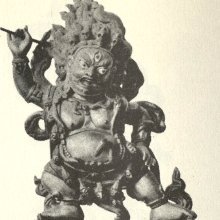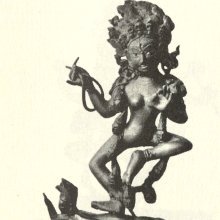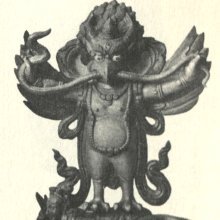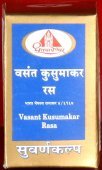Pushpa, Puṣpa, Puṣpā: 44 definitions
Introduction:
Pushpa means something in Buddhism, Pali, Hinduism, Sanskrit, Jainism, Prakrit, the history of ancient India, Marathi, Hindi. If you want to know the exact meaning, history, etymology or English translation of this term then check out the descriptions on this page. Add your comment or reference to a book if you want to contribute to this summary article.
The Sanskrit terms Puṣpa and Puṣpā can be transliterated into English as Puspa or Pushpa, using the IAST transliteration scheme (?).
Images (photo gallery)
(+9 more images available)
In Hinduism
Purana and Itihasa (epic history)
Source: Wisdom Library: Bhagavata PuranaPuṣpa (पुष्प):—Son of Hiraṇyanābha (son of Vidhṛti). He had a son named Dhruvasandhi. (see Bhāgavata Purāṇa 9.12.5)
Source: archive.org: Puranic EncyclopediaPuṣpa (पुष्प).—A serpent born of the family of Kaśyapa. (Śloka 13, Chapter 103, Udyoga Parva).
Source: archive.org: Shiva Purana - English TranslationPuṣpa (पुष्प, “flowers”) [=Puṣpaka?] refers to “offering of flowers” and represents one of the sixteen upacāra, or “sixteen types of homage and services”, as described while explaining the mode of worshipping the phallic form (liṅga) of Śiva in the Śivapurāṇa 1.11. Accordingly, “[...] the devotee shall worship the mobile emblem with the sixteen types of homage and services (upacāra) as prescribed. It accords the region of Śiva gradually. The sixteen types of service are [for example, offering of flowers (puṣpa)] [...] Or he shall perform all the sixteen rites in the phallic emblem of human, saintly or godly origin, or in one naturally risen up (svayambhū) or in one of very extraordinary nature installed duly”.
Puṣpa or Puṣpasamarpaṇa (flower offerings) is also mentioned in the Śivapurāṇa 1.20, while explaining the mode of worshipping an earthen phallic image (pārthiva-liṅga) according to the Vedic rites:—“[...] flower (puṣpa) offerings shall be made with the mantra ‘Namaḥ Pāryāya’ etc. Bilva leaves shall be offered with the mantra ‘Namaḥ Parṇāya’ etc.”.
Source: Cologne Digital Sanskrit Dictionaries: The Purana IndexPuṣpa (पुष्प).—The son of Hiraṇyanābha and father of Dhruvasandhi.*
- * Brahmāṇḍa-purāṇa III. 63. 209.
Puṣpa (पुष्प) is a name mentioned in the Mahābhārata (cf. V.101.13/V.103) and represents one of the many proper names used for people and places. Note: The Mahābhārata (mentioning Puṣpa) is a Sanskrit epic poem consisting of 100,000 ślokas (metrical verses) and is over 2000 years old.

The Purana (पुराण, purāṇas) refers to Sanskrit literature preserving ancient India’s vast cultural history, including historical legends, religious ceremonies, various arts and sciences. The eighteen mahapuranas total over 400,000 shlokas (metrical couplets) and date to at least several centuries BCE.
Shaktism (Shakta philosophy)
Source: Wisdom Library: ŚāktismPuṣpa (पुष्प, “flowers”):—One of the five preliminary oblations (upacāra) to be offered during the worship of Gaṇeśa, Durgā, Śiva and Viṣṇu, according to the Durgāpūjātattva.
Source: Google Books: Manthanabhairavatantram1) Puṣpa (पुष्प) is the name of the ‘secret seat’ associated with Jālandhara, one of the sacred seats (pīṭha), according to the Manthānabhairavatantra, a vast sprawling work that belongs to a corpus of Tantric texts concerned with the worship of the goddess Kubjikā.—Note: Another unusual feature of this setup is the addition of secret seats [i.e., Puṣpa], but this has not been done very systematically. One ‘secret’ seat is missing and only one ‘secret’ Siddha is mentioned. The purpose of this addition seems to be to integrate Koṅkaṇa into the scheme, not an entire set of alternative seats.
2) Puṣpa (पुष्प) (Cf. Puṣpita) refers to “menses” (i.e., menstrual discharge), according to the Manthānabhairavatantra, a vast sprawling work that belongs to a corpus of Tantric texts concerned with the worship of the goddess Kubjikā.—Accordingly, “The subtle form of the goddess is Kuṇḍalinī. Her names in the three transmissions—Khañjinī, Vakrā and Kubjikā—all imply her identity as Kuṇḍalinī. [...] She is called Anackā (Unstruck Sound) and has a copious and good menses [i.e., su-puṣpa-āḍhya]. (As Kuṇḍalinī) she transports (the individual soul) along the path of Suṣumṇā. Endless, she is at the extreme end of the Endless. Stainless, she is free of defects”.
Source: Shodhganga: Iconographical representations of Śiva (shaktism)Puṣpa (पुष्प) or Puṣpatantra refers to one of the thirty-three Dakṣiṇatantras, belonging to the Śāktāgama (or Śāktatantra) division of the Āgama tradition. The Śāktāgamas represent the wisdom imparted by Devī to Īśvara and convey the idea that the worship of Śakti is the means to attain liberation. According to the Pratiṣṭhālakṣaṇasamuccaya of Vairocana, the Śāktatantras are divided into to four parts, the Puṣpa-tantra belonging to the Dakṣiṇa class.

Shakta (शाक्त, śākta) or Shaktism (śāktism) represents a tradition of Hinduism where the Goddess (Devi) is revered and worshipped. Shakta literature includes a range of scriptures, including various Agamas and Tantras, although its roots may be traced back to the Vedas.
Ayurveda (science of life)
Nighantu (Synonyms and Characteristics of Drugs and technical terms)
Source: Wisdom Library: Raj Nighantu1) Puṣpa (पुष्प) or Puṣpavarga is another name for Karvīrādi: the tenth chapter of the 13th-century Raj Nighantu or Rājanighaṇṭu (an Ayurvedic encyclopedia). The Rāja-nighaṇṭu is a medical lexicon ascribed originally known as the Abhidhānacuṇāmaṇi. It mentions the names of 1483 medicinal drugs (auṣadhi) and substances (dravya) excluding synonyms, grouped into twenty-two chapters [viz., Puṣpa-varga].
2) Puṣpa (पुष्प) refers to a “flower”, as mentioned in a list of eight synonyms, according to the second chapter (dharaṇyādi-varga) verse 33.
Dietetics and Culinary Art (such as household cooking)
Source: Shodhganga: Dietetics and culinary art in ancient and medieval IndiaPuṣpa (पुष्प) refers to “flower” (part of a plant) and represents a type of vegetable (śāka) according to the 17th century Bhojanakutūhala (dravyaguṇāguṇa-kathana), and is commonly found in literature dealing with the topics of dietetics and culinary art, also known as Pākaśāstra or Pākakalā.—Śāka-prakaraṇa deals with all types of vegetables. Here vegetables are classified into different plant parts [like flower (puṣpa), etc.]. Each of these classification have so many varieties. This prakaraṇa is devoted to explain these varieties and their properties in detail.
Toxicology (Study and Treatment of poison)
Source: Shodhganga: Kasyapa Samhita—Text on Visha ChikitsaPuṣpa (पुष्प) or “flower” refers to one of the ten sources of plant poison, as described in the Kāśyapa Saṃhitā: an ancient Sanskrit text from the Pāñcarātra tradition dealing with both Tantra and Viṣacikitsā—an important topic from Āyurveda which deals with the study of Toxicology (Viṣavidyā or Sarpavidyā).—Kaśyapa states in the fourth Adhyāya that Śiva taught him that poisons are of five kinds viz. immobile, mobile, artificial, caused by planets and (arising out of) doubt. The sources of plant poison, ten in number are [viz. flower (puṣpa)]. The speed in which they spread too are varied (KS. XII.66):
Agriculture (Krishi) and Vrikshayurveda (study of Plant life)
Source: Shodhganga: Drumavichitrikarnam—Plant mutagenesis in ancient IndiaPuṣpa (पुष्प) refers to the “flowers (of a tree)” whose colors were commonly manipulated using recipes prescribed in the Vṛkṣāyurveda by Sūrapāla (1000 CE): an encyclopedic work dealing with the study of trees and the principles of ancient Indian agriculture.—Accordingly, “The white flowers (śveta-puṣpa) of a tree [śvetaṃ puṣpaṃ taroḥ] turn into a golden colour if the tree is watered with a mixture of Curcuma longa powder, Butea monosperma, Gossypium herbaceum seed, Rubia cordifolia and the Symplocos racemosa tree”.
Unclassified Ayurveda definitions
Source: Wisdom Library: Āyurveda and botanyPuṣpa (पुष्प) is a Sanskrit technical term translating to “flower” or “blossom” and is used throughout Ayurvedic literature such as the Suśrutasaṃhita or the Carakasaṃhita.
Source: gurumukhi.ru: Ayurveda glossary of terms1) Puṣpa (पुष्प):—Flower
2) [puṣpam] Flowers
3) [puṣpam] '(1)menstural discharge. (2) Ovum (Periodic discharge). Periodic discharge of blood and mucus from the uterus (2) The female reproductive or germ cell''

Āyurveda (आयुर्वेद, ayurveda) is a branch of Indian science dealing with medicine, herbalism, taxology, anatomy, surgery, alchemy and related topics. Traditional practice of Āyurveda in ancient India dates back to at least the first millenium BC. Literature is commonly written in Sanskrit using various poetic metres.
Natyashastra (theatrics and dramaturgy)
Source: Wisdom Library: Nāṭya-śāstra1) Puṣpa (पुष्प, “sweet words”) refers to ‘sweet words’ of gallantry. Puṣpa represents one of the thirteen pratimukhasandhi, according to the Nāṭyaśāstra chapter 21. Pratimukhasandhi refers to the “segments (sandhi) of the progressing part (pratimukha)” and represents one of the five segments of the plot (itivṛtta or vastu) of a dramatic composition (nāṭaka).
2) Puṣpa (पुष्प) refers to one of the four kinds of vyañjana (indication), according to the Nāṭyaśāstra chapter 29. Vyañjana represents one of the four classes of dhātu (stroke), which relate to different aspects of strokes in playing stringed instruments (tata).
According to the Nāṭyaśāstra, “puṣpa is one stroke with the little finger and the thumb”.
Source: archive.org: Natya ShastraPuṣpa (पुष्प).—One of the twelve elements of the ‘progression segment’ (pratimukhasandhi);—(Description:) Mentioning some favourable peculiarity is called Sweet Words (puṣpa, lit. flower).

Natyashastra (नाट्यशास्त्र, nāṭyaśāstra) refers to both the ancient Indian tradition (shastra) of performing arts, (natya—theatrics, drama, dance, music), as well as the name of a Sanskrit work dealing with these subjects. It also teaches the rules for composing Dramatic plays (nataka), construction and performance of Theater, and Poetic works (kavya).
Shaivism (Shaiva philosophy)
Source: Shodhganga: Temple management in the ĀgamasPuṣpa (पुष्प) or Kusuma refers to “fragrant flowers” and represents one of the various upacāras (offerings), in pūjā (ritual worship), as defined in the Śaivāgamas.—Pūjā consists of offering hospitality, in the form of water to wash the feet, to drink, water for ablutions, offering a bath, new clothes, fragrant unguents, fragrant flowers and ornaments, food and so on. Each step in the pūjā process is called “saṃskāra” and each offering is called “upacāra” [viz., Puṣpa].
Source: SOAS University of London: Protective Rites in the Netra TantraPuṣpa (पुष्प) refers to “flowers” (used in worship), according to the Netratantra of Kṣemarāja: a Śaiva text from the 9th century in which Śiva (Bhairava) teaches Pārvatī topics such as metaphysics, cosmology, and soteriology.—Accordingly, [verse 2.20-22ab]—“[The Mantrin] should worship the mother of mantras with the highest bhakti, by spreading flowers and perfume (puṣpa—puṣpadhūpādivistaraiḥ), O Devī. He should extract the deity invoked by the Mantra [with the mantra]. Beginning with the all-pervading and ending with manifold [oṃ], [he should] always [worship with] the nectar of the white flower. The bright sound is highest Śakti, [who] resembles one-in-the-same Śiva. By this [worship] the pearls [of the mantra] are all bound in a cord”.

Shaiva (शैव, śaiva) or Shaivism (śaivism) represents a tradition of Hinduism worshiping Shiva as the supreme being. Closely related to Shaktism, Shaiva literature includes a range of scriptures, including Tantras, while the root of this tradition may be traced back to the ancient Vedas.
Vaishnavism (Vaishava dharma)
Source: Pure Bhakti: Arcana-dipika - 3rd EditionPuṣpa (पुष्प) refers to “flowers” and represents one of the articles offered during Maṅgalārati, according to the Arcana-dīpikā (manual on deity worship).—Before each article is offered, purify the right hand [with a drop of water from the pañca-pātra], and then purify the article [viz., puṣpa]. Chant the mūla-mantra for the deity and then offer the article.

Vaishnava (वैष्णव, vaiṣṇava) or vaishnavism (vaiṣṇavism) represents a tradition of Hinduism worshipping Vishnu as the supreme Lord. Similar to the Shaktism and Shaivism traditions, Vaishnavism also developed as an individual movement, famous for its exposition of the dashavatara (‘ten avatars of Vishnu’).
Jyotisha (astronomy and astrology)
Source: Wisdom Library: Brihat Samhita by VarahamihiraPuṣpa (पुष्प) or Kusuma refers to the “heart-bladder”, according to the Bṛhatsaṃhitā (chapter 8), an encyclopedic Sanskrit work written by Varāhamihira mainly focusing on the science of ancient Indian astronomy astronomy (Jyotiṣa).—Accordingly, “The Nakṣatras—Rohiṇī and Kṛttikā, form the body of the Vatsara Puruṣa, the two Āṣāḍhas form his navel, Āśleṣā forms the heart and Maghā, the heart-bladder [i.e., kusuma]; when benefíc planets pass through these, there will be happiness in the land; if malefic planets should pass through the body, there will be suffering from fire and winds; if they should pass through the navel, there will be suffering from starvation; if they should pass through the heart-bladder [i.e., puṣpa], roots and fruits will suffer, and if they should pass through the heart, crops will perish”.
Source: Google Books: Studies in the History of the Exact Sciences (Astronomy)Puṣpa (पुष्प) refers to “flowers”, according to the Nāradasaṃhitā verse 29.86-95 (pp. 181-184), a Sanskrit work on astrology having the Saralā commentary by Vasatirāma Śarmā.—Accordingly, “[...] In an auspicious copper basin, or in a clay basin that has been filled with water, having decorated it with effort by means of sandal paste, flowers and coloured rice [i.e., gandha-puṣpa-akṣata], the basin which is placed upon grains of rice, to which a gold piece is added and which is covered by a pair of clothes, one should place the bowl after having seen the rise of half of the Sun’s orb. [...]”.

Jyotisha (ज्योतिष, jyotiṣa or jyotish) refers to ‘astronomy’ or “Vedic astrology” and represents the fifth of the six Vedangas (additional sciences to be studied along with the Vedas). Jyotisha concerns itself with the study and prediction of the movements of celestial bodies, in order to calculate the auspicious time for rituals and ceremonies.
General definition (in Hinduism)
Source: ACHC: Smarta PujaPuṣpa (पुष्प) refers to “offering flowers”, representing one of the various services (upacāra) of a pūjā (ritualistic worship of a deity) which aim at the purification of the devotee.—Next [after akṣata] the devotee offers carefully selected fresh flowers (puṣpa) and leaves of the season (ṛtukālodbhava), which are usually kept in a special container (puṣpa-bhājana). There are elaborate rules for the use of certain flowers in the worship of particular deities. Durvā grass—liked by elephants—should be given to Ganapati but not to Devī, tulaśi to Viṣṇu but not to Ganapati, bilva leaves are to be offered to Śiva but not to Sūrya. Certain stories from the Puranic literature try to give reasons for these rules. Thus Mudgala-Purāṇa 5.31 explains the enmity between tulasi and Ganapati as leading to the prohibition of tulasi leaves in Ganapati’s worship. In kāmya-pūjās worship with certain flowers is believed to lead to certain desired results.
In Buddhism
Tibetan Buddhism (Vajrayana or tantric Buddhism)
Source: Wisdom Library: Tibetan BuddhismPuṣpa (पुष्प) is the name of a Śrāvaka mentioned as attending the teachings in the 6th century Mañjuśrīmūlakalpa: one of the largest Kriyā Tantras devoted to Mañjuśrī (the Bodhisattva of wisdom) representing an encyclopedia of knowledge primarily concerned with ritualistic elements in Buddhism. The teachings in this text originate from Mañjuśrī and were taught to and by Buddha Śākyamuni in the presence of a large audience (including Puṣpa).

Tibetan Buddhism includes schools such as Nyingma, Kadampa, Kagyu and Gelug. Their primary canon of literature is divided in two broad categories: The Kangyur, which consists of Buddha’s words, and the Tengyur, which includes commentaries from various sources. Esotericism and tantra techniques (vajrayāna) are collected indepently.
Mahayana (major branch of Buddhism)
Source: academia.edu: A Study and Translation of the GaganagañjaparipṛcchāPuṣpa (पुष्प) refers to “(showering) flowers”, according to the Gaganagañjaparipṛcchā: the eighth chapter of the Mahāsaṃnipāta (a collection of Mahāyāna Buddhist Sūtras).—Accordingly, “[...] Then, by the unconditioned magical power of manifestation, by the miraculous performances (vikrīḍita) of the Buddha [Ekaratnavyūha], [Gaganagañja with the other Bodhisattvas] teleported from the Mahāvyūha universe to the Sahā universe, in one moment of thought, and sat down there. They showered flowers, garlands (puṣpa-mālya), powders, perfumes, unguents, parasols, banners, flags from the Mahāvyūha universe pouring down as rain”
Source: De Gruyter: A Buddhist Ritual Manual on AgriculturePuṣpa (पुष्प) or Puṣpasaṃdhāraṇī refers to the “(protection of) flowers” as occurring in the Heart-mantra (hṛdayamantra) taught to Vajrapāṇi, according to the Vajratuṇḍasamayakalparāja, an ancient Buddhist ritual manual on agriculture from the 5th-century (or earlier), containing various instructions for the Sangha to provide agriculture-related services to laypeople including rain-making, weather control and crop protection.

Mahayana (महायान, mahāyāna) is a major branch of Buddhism focusing on the path of a Bodhisattva (spiritual aspirants/ enlightened beings). Extant literature is vast and primarely composed in the Sanskrit language. There are many sūtras of which some of the earliest are the various Prajñāpāramitā sūtras.
In Jainism
General definition (in Jainism)
Source: Wisdom Library: JainismPuṣpa (पुष्प, “flower”).—One of the ten kinds of “plant-bodies” (vanaspati) a soul (jīva) can be reborn as due to karma. Puṣpa and other plant-bodies are within the animal world (tiryag-gati) which is one of the four divisions of saṃsāra where souls are reborn.
Source: archive.org: TrisastisalakapurusacaritraPuṣpa (पुष्प) is the name of an ancient king from Śvetapura, according to chapter 3.7 [suvidhinātha-caritra] of Hemacandra’s 11th century Triṣaṣṭiśalākāpuruṣacaritra: an ancient Sanskrit epic poem narrating the history and legends of sixty-three illustrious persons in Jainism.
Accordingly, “[...] In the evening on the sixth day of the black half of Mārga (the moon being) in Mūla, together with a thousand kings the Lord became a mendicant accompanied by a two days’ fast. On the next day the Supreme Lord broke his fast with rice-pudding in the house of King Puṣpa in the city Śvetapura. The gods made the five things, the rain of treasure, etc., and King Puṣpa made a jeweled platform on the place of the Master’s feet. With an extraordinary body, free from affection, free from worldly interest, enduring trials, the Lord of the World wandered for four months as an (unenlightened) ascetic”
Source: The University of Sydney: A study of the Twelve ReflectionsPuṣpa (पुष्प) refers to the “blossom (of virtue)”, according to the 11th century Jñānārṇava, a treatise on Jain Yoga in roughly 2200 Sanskrit verses composed by Śubhacandra.—Accordingly, “Glory to the great tree that is stopping the influx of karma whose opponent is conquered, which is rooted in all the rules of conduct for a mendicant, whose great trunk is restraint, whose full branches are tranquillity, which is covered with the blossom of virtue (dharmapuṣpa-avakīrṇa) [and] is beautiful because of producing whole fruit through the reflections. [Thus ends the reflection on] stopping the influx of karma”.
Synonyms: Prasūna .

Jainism is an Indian religion of Dharma whose doctrine revolves around harmlessness (ahimsa) towards every living being. The two major branches (Digambara and Svetambara) of Jainism stimulate self-control (or, shramana, ‘self-reliance’) and spiritual development through a path of peace for the soul to progess to the ultimate goal.
India history and geography
Source: archive.org: Personal and geographical names in the Gupta inscriptionsPuṣpa (पुष्प).—Gupta inscription No. 1 mentions a city named Puṣpa where Samudragupta enjoyed playfully while he was young. Apparently, the city was the Gupta capital. Also see Pāṭaliputra.
Source: Cologne Digital Sanskrit Dictionaries: Indian Epigraphical GlossaryPuṣpa.—(IE 8-8), a coin having the shape or sign of flower. Cf. a-harītaka-śāka-puṣpa-grahaṇa (IE 8-5), flowers which the villagers (probably, the florists) were obliged to supply to the king or landlord on occasions or to the touring officials. Note: puṣpa is defined in the “Indian epigraphical glossary” as it can be found on ancient inscriptions commonly written in Sanskrit, Prakrit or Dravidian languages.

The history of India traces the identification of countries, villages, towns and other regions of India, as well as mythology, zoology, royal dynasties, rulers, tribes, local festivities and traditions and regional languages. Ancient India enjoyed religious freedom and encourages the path of Dharma, a concept common to Buddhism, Hinduism, and Jainism.
Languages of India and abroad
Marathi-English dictionary
Source: DDSA: The Molesworth Marathi and English Dictionarypuṣpa (पुष्प).—n (S) A flower. 2 The menses, vulgo flowers. 3 A disease of the eyes, albugo. 4 The uterus at large or the ovarium. See under phūla. puṣpa ṭhēvaṇēṃ To cast blame upon.
Source: DDSA: The Aryabhusan school dictionary, Marathi-Englishpuṣpa (पुष्प).—n A flower. The menses. A disease of the eyes, albugo.
Marathi is an Indo-European language having over 70 million native speakers people in (predominantly) Maharashtra India. Marathi, like many other Indo-Aryan languages, evolved from early forms of Prakrit, which itself is a subset of Sanskrit, one of the most ancient languages of the world.
Sanskrit dictionary
Source: DDSA: The practical Sanskrit-English dictionaryPuṣpa (पुष्प).—[puṣp vikāśe-ac]
1) A flower, blossom; पत्रं पुष्पं फलं तोयं यो मे भक्त्या प्रयच्छति (patraṃ puṣpaṃ phalaṃ toyaṃ yo me bhaktyā prayacchati) Bhagavadgītā (Bombay) 9.26.
2) The menstrual discharge; as in पुष्पवती (puṣpavatī) q. v.
3) A topaz (puṣparāga); Rām.2.94.6.
4) A disease of the eyes (albugo).
5) The car or vehicle of Kubera; see पुष्पक (puṣpaka).
6) Gallantry, politeness (in love language).
7) Expanding, blooming, blossoming (said to be m. in this sense).
Derivable forms: puṣpam (पुष्पम्).
--- OR ---
Puṣpā (पुष्पा).—Name of the town Champā, the modern Bhāgalpur.
Source: Cologne Digital Sanskrit Dictionaries: Edgerton Buddhist Hybrid Sanskrit DictionaryPuṣpa (पुष्प).—m., (1) as common noun, flower (regularly nt.): puṣpāṃ = °pān, acc. pl., Lalitavistara 92.16; (2) name of a plurality of former Buddhas, puṣpa-nāmaka or the like, numbering 300: Mahāvastu i.46.3, but 3 crores, 58.4; 61.13; name of an individual former Buddha, iii.239.7—8, 432.12; oc- curs also as v.l. for Puṣya (1), q.v., in mss. and some edd.; (3) name of a future Buddha (compare Puṣya 2): Mahāvastu ii.355.12 = iii.279.17; (4) name of a king: Puṣpa-nāmo (Ārya-)Mañjuśrīmūlakalpa 625.22 (possibly means with a name containing the etement puṣpa, and may even refer to more than one king).
--- OR ---
Puṣpā (पुष्पा).—name of a goddess or yoginī: Sādhanamālā 157.12 etc.; 324.6.
Source: Cologne Digital Sanskrit Dictionaries: Shabda-Sagara Sanskrit-English DictionaryPuṣpa (पुष्प).—n.
(-ṣpaṃ) 1. A flower in general. 2. The menses. 3. Expansion, expanding. 4. The vehicle or car of Kuvera. 5. A disease of the eyes, specks on the eye, albugo. 6. A topaz. 7. Gallantry, politeness, (in erotic poetry.) f.
(-ṣpā) The capital of Karna, or Bhagalpur. m.
(-ṣpaḥ) Blossoming, blooming, expanding. E. puṣpa to flower, &c. ac aff.
--- OR ---
Puṣpā (पुष्पा).—m.
(-ṣpā) The district of Bhagalpur or the name of its capital champa.
Source: Cologne Digital Sanskrit Dictionaries: Benfey Sanskrit-English DictionaryPuṣpa (पुष्प).—[puṣ + pa], I. n. 1. A flower, [Nala] 13, 3. 2. The menses, Mārk. P. 51, 42. 3. The vehicle or car of Kuvera. 4. A disease of the eyes, albugo. 5. A topaz, [Rāmāyaṇa] 2, 94, 6 (cf. puṣpa-rāga). Ii. m. A proper name. Iii. f. pā, The capital of Karṇa.
Source: Cologne Digital Sanskrit Dictionaries: Cappeller Sanskrit-English DictionaryPuṣpa (पुष्प).—[neuter] bloom, flower (adj. —° [feminine] ā or ī); [masculine] topaz, a man’s name.
Source: Cologne Digital Sanskrit Dictionaries: Monier-Williams Sanskrit-English Dictionary1) Puṣpa (पुष्प):—[from puṣ] n. (for puṣka?) a flower, blossom (ifc. f(ā). , in names of plants oftener f(ī). ; cf. [Pāṇini 4-1, 64], [vArttika] 1), [Atharva-veda] etc. etc.
2) [v.s. ...] the menstrual flux, [Suśruta]
3) [v.s. ...] a [particular] disease of the eye, albugo, [Suśruta]
4) [v.s. ...] a spot on the nails and teeth, [Caraka]
5) [v.s. ...] (in [dramatic language]) gallantry, politeness, declaration of love, [Daśarūpa; Sāhitya-darpaṇa; Pratāparudrīya]
6) [v.s. ...] Name of a Sāman, [Tāṇḍya-brāhmaṇa; Lāṭyāyana]
7) [v.s. ...] of a book, [Divyāvadāna]
8) [v.s. ...] a kind of perfume, [cf. Lexicographers, esp. such as amarasiṃha, halāyudha, hemacandra, etc.]
9) [v.s. ...] the vehicle of Kubera, [cf. Lexicographers, esp. such as amarasiṃha, halāyudha, hemacandra, etc.]
10) [v.s. ...] blooming, expanding, [cf. Lexicographers, esp. such as amarasiṃha, halāyudha, hemacandra, etc.]
11) [v.s. ...] m. a topaz, [Rāmāyaṇa]
12) [v.s. ...] Name of a serpent-demon, [Mahābhārata]
13) [v.s. ...] of a son of Ślīṣṭi, [Harivaṃśa]
14) [v.s. ...] of a son of Śaṅkha, [ib.] ([Calcutta edition] puṣya)
15) [v.s. ...] of a Bodhi-sattva (?), [Lalita-vistara]
16) [v.s. ...] of a mountain, [Mārkaṇḍeya-purāṇa]
17) [v.s. ...] of a book ([probably] = puṣpa-sūtra), [Divyāvadāna]
18) Puṣpā (पुष्पा):—[from puṣpa > puṣ] f. Name of the town Campā, [cf. Lexicographers, esp. such as amarasiṃha, halāyudha, hemacandra, etc.]
Source: Cologne Digital Sanskrit Dictionaries: Yates Sanskrit-English Dictionary1) Puṣpa (पुष्प):—(ṣpaṃ) 1. n. A flower in general; menses; expansion; albugo; car of Kuvera. f. (ṣpā) Bhāgalpur.
2) hāsā (sā) 1. f. A woman during the time of menstruation.
Source: DDSA: Paia-sadda-mahannavo; a comprehensive Prakrit Hindi dictionary (S)Puṣpa (पुष्प) in the Sanskrit language is related to the Prakrit words: Puppha, Phullayā.
[Sanskrit to German]
Sanskrit, also spelled संस्कृतम् (saṃskṛtam), is an ancient language of India commonly seen as the grandmother of the Indo-European language family (even English!). Closely allied with Prakrit and Pali, Sanskrit is more exhaustive in both grammar and terms and has the most extensive collection of literature in the world, greatly surpassing its sister-languages Greek and Latin.
Hindi dictionary
Source: DDSA: A practical Hindi-English dictionaryPuṣpa (पुष्प) [Also spelled pushp]:—(nm) a flower; menses; —[kāla] period of menses; —[kesara] stamen; ~[garbha] calix, calyx; —[patra] petal of a flower; ~[bāṇa/dhanvā/śara/sāyaka] an epithet of Cupid ([kāmadeva]); ~[maya] flowery; —[māla/—mālā] a wreath; flower garland; —[raja] stamen (of flowers); —[rāga] pollen; —[reṇu] pollen (of flowers); ~[vatī] a woman in menses; -[vṛṣṭi] a shower of flowers or flower petals; -[veṇī] a flower garland; braid studded with flowers; —[śaiyā] a bed of flowers; —[saṃbaṃdhī] floral; ~[hīna] devoid of flowers; flowerless; ~[hīnā] a barren woman.
...
Kannada-English dictionary
Source: Alar: Kannada-English corpusPuṣpa (ಪುಷ್ಪ):—
1) [noun] the blossom of a plant, containing colourful petals, pollen-bearing stamens, etc.; a flower.
2) [noun] (in women) the periodic flow of blood and sloughed-off tissue from the uterus, discharged through the genital tract.
3) [noun] a dense, white opacity of the cornea, an eye-disease; albugo; leucoma.
4) [noun] a kind of medicated eyewash for the eyes.
5) [noun] a particular mark or a ditinctive feature on the body of a horse.
6) [noun] (hist.) a particular monetary coin.
7) [noun] a silicate of aluminum and fluorine, usu. containing hydroxyl and occurring in white, yellow, pale-blue or pale-green orthorhombic crystals, used as a gem.
Kannada is a Dravidian language (as opposed to the Indo-European language family) mainly spoken in the southwestern region of India.
See also (Relevant definitions)
Starts with (+357): Pushpabali, Pushpabana, Pushpabanavilasa, Pushpabatuka, Pushpabhadra, Pushpabhadraka, Pushpabhajana, Pushpabhakshi, Pushpabhanda, Pushpabhanga, Pushpabhasa, Pushpabhava, Pushpabherotsa, Pushpabhikirna, Pushpabhisheka, Pushpabhushana, Pushpabhushita, Pushpabhuti, Pushpacamara, Pushpacanan.
Ends with (+321): Abhipushpa, Abhrapushpa, Adhahpushpa, Adyapushpa, Agastyapushpa, Agnikshamapushpa, Ahipushpa, Akalapushpa, Akashapushpa, Amarapushpa, Ambarapushpa, Anaghranitapushpa, Anandapushpa, Andakotarapushpa, Andakotharapushpa, Angarapushpa, Antahpushpa, Anupushpa, Apurupushpa, Apushpa.
Full-text (+970): Indrapushpa, Pushpavati, Tikshnapushpa, Madhupushpa, Anupushpa, Tishyapushpa, Pushpalih, Nishipushpa, Pushpasara, Pushpasveda, Pushpacapa, Pushpahina, Pitapushpa, Pushpastra, Pushparenu, Pushpamdhaya, Pushpakasisa, Bhutapushpa, Lakshmipushpa, Pushpanjana.
Relevant text
Search found 91 books and stories containing Pushpa, Puṣpa, Puṣpā, Puspa; (plurals include: Pushpas, Puṣpas, Puṣpās, Puspas). You can also click to the full overview containing English textual excerpts. Below are direct links for the most relevant articles:
Tiruvaymoli (Thiruvaimozhi): English translation (by S. Satyamurthi Ayyangar)
Pasuram 9.10.2 < [Section 10 - Tenth Tiruvaymoli (Malai nanni)]
Amarakoshodghatana of Kshirasvamin (study) (by A. Yamuna Devi)
Flora (14): Vegetables < [Chapter 5 - Aspects of Nature]
Division of Time < [Chapter 3 - Social Aspects]
Politics and Administration (1): The State requisites of regal administration < [Chapter 3 - Social Aspects]
Garga Samhita (English) (by Danavir Goswami)
Verse 2.24.7 < [Chapter 24 - The Story of Asuri Muni in the Rāsa-dance Pastime]
Verse 2.20.12 < [Chapter 20 - The Rāsa-dance Pastime]
Verse 5.10.18 < [Chapter 10 - The Stories of the Washerman, Weaver, and Florist]
Hari-bhakti-kalpa-latikā (by Sarasvati Thkura)
Text 7 < [Second Stabaka]
Sahitya-kaumudi by Baladeva Vidyabhushana (by Gaurapada Dāsa)
Text 7.26 < [Chapter 7 - Literary Faults]
Text 7.112 < [Chapter 7 - Literary Faults]
Text 10.158 < [Chapter 10 - Ornaments of Meaning]
Shrimad Bhagavad-gita (by Narayana Gosvami)
Verse 9.26 < [Chapter 9 - Rāja-guhya-yoga (Yoga through the most Confidential Knowledge)]
Related products
(+41 more products available)











